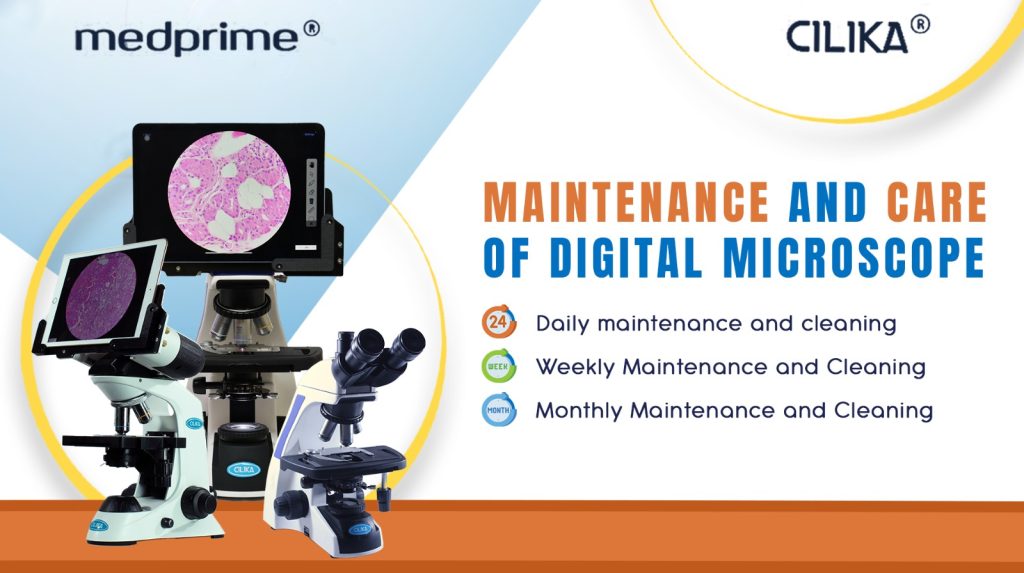Digital microscopes are an essential tool for scientific research and analysis, providing high-resolution imaging capabilities for a range of applications. As with any laboratory equipment, proper maintenance and care are critical to ensure optimal performance and longevity. In this blog, we’ll explore some best practices for maintaining and caring for digital microscopes, so that they can provide accurate and reliable results for many years to come. From cleaning and storage to software updates and preventative maintenance, we’ll cover everything you need to know to keep your digital microscopes performing at their best. So let’s get started and ensure that your digital microscopes stay in top condition!
Importance of Maintenance and Care for Digital Microscopes
Regular optical and mechanical maintenance of digital microscopes is essential to maintain their efficiency, effectiveness, and image quality. Digital microscopes should be maintained after every 150-200 hours of usage. For pathology labs that spend about 12-15 hours a day on microscopes, it would translate to conducting maintenance after every 18-20 days of usage.
Daily Maintenance and Cleaning of Digital Microscopes
Cleaning forms an integral part of a microscope’s daily maintenance routine. Most importantly, you must often clean the microscope’s objective lenses. 40x and 100x lens due to their longer length often come in contact with the sample slide and immersion oil. These contaminants, if not cleaned immediately, can slowly corrode and damage the outer layer of the lens, reducing the resolution and performance of the objective.
Now, how do you clean an objective lens? Take a soft brush or blow off with air pressure from a rubber syringe to remove the dust particles. Lightly touch a soft tissue or blotting paper to the lens to absorb excess oil, if present. Next, gently wipe in a circular motion with soft lens tissue with lens cleaning solution or distilled water. Further, take a clean lens paper and dry it immediately in a circular motion.
However, you must remember that you must not disassemble the objectives. If you feel there’s a need for internal cleaning or repairs, you must have a qualified and authorized microscope repair professional to do it efficiently and safely.
Weekly Maintenance and Cleaning of Digital Microscopes
Microscope cleaning must be performed in two parts – regular wiping, performed after every use, and occasional deep cleans. In case you use your microscope daily and work with messy oils and specimens, you should clean it once a week.
Weekly deep cleaning can require a significant amount of external and internal cleaning. You must connect with an expert to do so, as your microscope consists of many delicate and intricate parts internally, which should be handled by experts to avoid damage.
Monthly Maintenance and Cleaning of Digital Microscopes
Monthly maintenance and cleaning of digital microscopes involve using a wipe and removing the dust from the eyepieces without removing them. You can complete the monthly cleaning by spraying the eyepieces with a compressed air vaporizer.
Calibration of Digital Microscopes: Why and How Often?
The frequency at which recalibration is needed for a digital microscope may vary from brand to brand. For eg. with Cilika microscopes, first calibration is done at the time of installation. Recalibration is required only if the tablet or mobile phone is replaced, or if the Cilika app has been reinstalled. Taking images or measurements using incorrect calibrations can lead to incorrect magnification indication and measurement values. The user will have to perform the whole procedure again in such cases.
Tips for Storing and Transporting Digital Microscopes
Let’s look at storing and transporting digital microscopes.
Storage
- Cover the microscope with the dust cover when you aren’t using it
- Store the microscope in a dry place
- In humid weather, store it in a waterproof container with a drying agent
- Avoid touching the optical lens with bare fingers
- Do not expose the microscope to direct sunlight
Transporting
Always lift the microscope with two hands. Keep one hand on the arm and support the base with the other.
Upgrades and Software Updates for Digital Microscopes
Upgrading your laboratory microscope proves helpful, as it enhances the microscope’s efficiency. It could involve a few factors, like the following.
- Upgrading the camera for improved sensitivity, reduced image noise, and higher resolution, and enabling the study of dynamic processes
- Replacing the older illumination with contemporary options for efficient control, enhanced contrast, and live cell imaging.
- Adding simultaneous multichannel imaging
- Adding automation to reduce fatigue while working on the microscope, opening up imaging possibilities, enabling multi field imaging, etc.
- Enhancing your microscope’s capabilities to support a super-resolution
Best Practices for Extending the Lifespan of Digital Microscopes
Extending the longevity of your microscope is possible with the below.
- Storing the microscope with utmost care and following the precautions
- Cleaning immersion oil and dust from lenses after every use
- Treating the microscope’s optical parts with care
- Servicing the microscope regularly to avoid inefficiencies and major breakdowns
Are you looking for digital laboratory microscopes? Connect with Medprime. We are an elite microscopy solution, and service provider. Our microscopes pack a range of innovative features that help make digital microscopy simpler and more effective. Additionally, our exemplary after-sales support helps you maintain the microscope and increase its longevity. For more details, please email us at contact@medprimetech.com.
